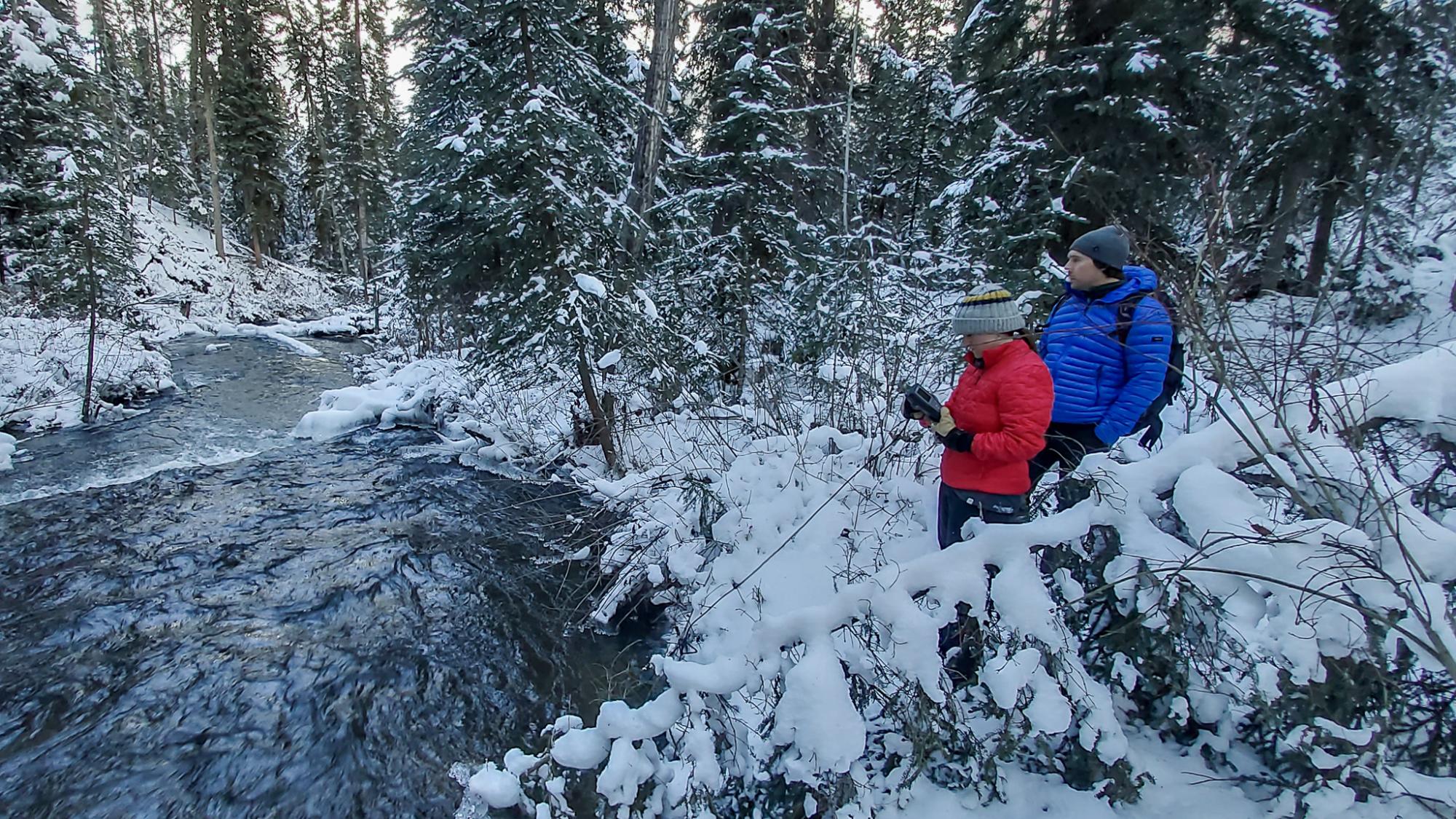 The McIntyre Creek Hydrology Research Project started as a vision to take advantage of the presence of a watercourse at walking distance from the Yukon University Ayamdigut Campus to support a range of academic activities, from training students in using sophisticated monitoring instruments to leading cold region hydrology research activities. In the context of this ongoing project, the creek, Chasàn Chùa, which means Copper Creek in Southern Tutchone, may be considered as a living laboratory, with water constantly flowing in a natural channel surrounded by forest, flourishing with life in a semi-urbanized setting.
The McIntyre Creek Hydrology Research Project started as a vision to take advantage of the presence of a watercourse at walking distance from the Yukon University Ayamdigut Campus to support a range of academic activities, from training students in using sophisticated monitoring instruments to leading cold region hydrology research activities. In the context of this ongoing project, the creek, Chasàn Chùa, which means Copper Creek in Southern Tutchone, may be considered as a living laboratory, with water constantly flowing in a natural channel surrounded by forest, flourishing with life in a semi-urbanized setting.
Small headwater creeks in northern environments have received relatively little scientific attention compared with their larger or southern counterparts, especially during the winter when monitoring becomes difficult for researchers and instruments. This headwater-winter context is a gap in hydrological sciences. These creeks continue to flow year-round, and their cumulative number represents a large and unique habitat. The fact that winter is a largely understudied and misunderstood season in cold region hydrology can be seen in hydrometric records (including both water quality and water quantity parameters): data is generally of poor accuracy if it even exists (and this applies to approximately half of the year!). This is a problem for the private sector (e.g., mining companies or small hydro-energy producers) as well as for the public sector (e.g., regulators responsible to enforce water quality standards).
The objective of the project is to 1. Train students for data collection and data analysis to better understand creek conditions year-round, 2. Collect hydrology baseline data specific to the creek to answer current and future questions, 3. Perform targeted research projects to improve our understanding of small streams in cold regions.
The project started during the fall of 2020 with regular visits at several sites along the creek to document winter processes and measure water quality parameters. In the middle of Hydrological Year 1 (October 2020 to September 2021), aquatic sensors were installed to measure water temperature, depth, and conductivity at three sites located close to campus. Remote cameras were deployed during Hydrological Year 2 (October 2021 to September 2022) to document ice formation processes. Now entering Hydrological Year 3, our team of several researchers and students will collect data with a focus on the winter season. There are five permanent monitoring stations and two temporary cameras. Our team regularly visits monitoring sites with a portable water temperature and conductivity meter. The team is also taking turbidity samples using a flow measurement device and will be testing a new automated camera setup adapted to capture night-time creek images. Groundwater-surface water interaction research will begin during the summer of 2023.
This work by our hydrology team in the Climate Change Research group complements the research done in the nearby Wolf Creek watershed investigating cold region natural science processes since 1993. Research sites in the Wolf Creek watershed were established by Dr. John Pomeroy and the late Richard Janowicz, and they are currently operated jointly between Dr. Sean Carey from McMaster University and the Water Resources Branch of the Yukon Government.
- Dr. Benoit Turcotte, P.Eng., Climate Change Research, YukonU Research Centre
- Stephanie Saal, Climate Change Research, YukonU Research Centre
- Dr. Ashley Dubnick, Climate Change Research, YukonU Research Centre
- Mederic Girard, Climate Change Research, YukonU Research Centre
- Chantelle Gervais, student
- Anna Smith, student
- Maude Bergeron Lambert, student
Several stakeholders and rights holders have interests in McIntyre Creek and some of these interests may diverge. In the interest of maintaining scientific neutrality, the project is currently running on academic and federal funding.
- YukonU internal Scholarly Activity Grants (SAG) have been used to pay for student salaries as well as to purchase portable monitoring instruments
- ArcticNet North-by-North funds are used to pay for researchers’ time on this project as well as to purchase permanent monitoring instruments
The project team would like to acknowledge the data shared by ATCO (through their contractor EDI / Environmental Dynamics) as well as the collaboration of Al von Finster, biologist, and fish habitat expert.
Right holders and stakeholders are always invited to contribute to or request data sets from the project. Nature is always the best setting to learn about our environment.